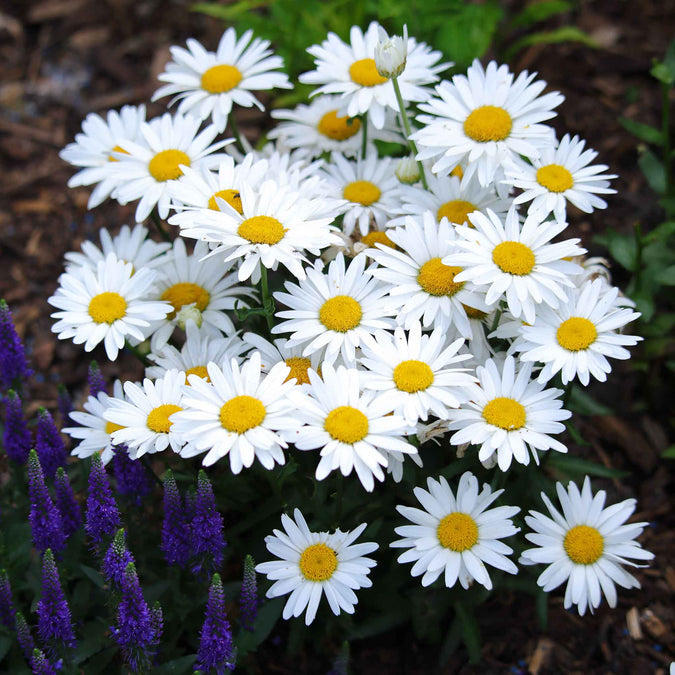
Dharaseeds
Daisy Seeds - Shasta
Estimated Free Delivery between April 16 and April 19.
Secured Payment Methods
Your transaction is protected with advanced security measures to keep your information confidential
Daisy Seeds - Shasta
The Shasta Daisy is a popular and cheerful perennial that brings a touch of brightness to any garden. With its classic white petals and yellow center, this variety is a timeless symbol of simplicity and beauty. Shasta Daisies are known for their long-lasting blooms, sturdy growth, and resilience, making them a favorite among both beginner and experienced gardeners. These flowers are perfect for borders, cut flower gardens, or naturalizing in meadows.
Key Benefits
- Bright, Cheerful Blooms: White petals with a yellow center bring a vibrant, fresh look to gardens.
- Long-Lasting Flowers: Shasta Daisies bloom over an extended period, offering consistent beauty from early summer to fall.
- Low Maintenance: Known for being easy to grow, making them a great choice for both new gardeners and seasoned enthusiasts.
- Pollinator-Friendly: Attracts bees, butterflies, and other pollinators, supporting a healthy garden ecosystem.
- Versatile in Landscaping: Perfect for garden borders, cut flowers, containers, or wildflower meadows.
Variety Features
- Plant Characteristics: Shasta Daisies have tall, strong stems with bright green, lance-shaped leaves and showy, white flowers with a distinctive yellow center.
- Flower Size: The flowers can grow up to 3-4 inches in diameter, making them a striking addition to any garden.
- Growth Habit: These plants form dense clumps and are known for their upright growth, reaching heights of 18-36 inches tall, depending on growing conditions.
Planting Instructions
Planting Season
- Ideal for spring planting after the last frost, or in fall for a spring bloom.
- Thrives in moderate to cooler temperatures, typically between 60°F–75°F (15°C–24°C).
Planting Details
- Seed Depth: Sow seeds 1/4 inch deep into the soil.
- Spacing: Space plants 12–18 inches apart for optimal growth and air circulation.
- Soil Requirements: Prefers well-drained, fertile, loamy soil with a slightly acidic to neutral pH (6.0–7.5).
- Sunlight: Shasta Daisies thrive in full sun, requiring at least 6 hours of direct sunlight per day for best results.
Care Instructions
Watering
- Keep soil moderately moist, especially during the growing season.
- Water deeply to encourage healthy root growth, but avoid waterlogging the soil.
Fertilization
- Apply a balanced, slow-release fertilizer in early spring as new growth begins, and again mid-summer for continued blooming.
- Too much nitrogen can cause the plant to become too leafy and reduce flowering, so use fertilizers in moderation.
Deadheading and Pruning
- To encourage more blooms, deadhead spent flowers regularly.
- Prune back plants in late fall or early spring to remove dead foliage and promote healthy growth.
Pest and Disease Control
- Pests: Generally pest-resistant, but keep an eye out for aphids or slugs, which may occasionally damage the leaves or flowers. Use insecticidal soap or natural remedies to control pests.
- Diseases: Shasta Daisies are prone to powdery mildew, especially in humid climates. Ensure good air circulation, and avoid overhead watering to reduce the risk.
Harvesting
- Maturity: Shasta Daisies bloom in about 60–90 days from seed, depending on the planting time and growing conditions.
- Method: To harvest flowers for arrangements, cut them in the morning when they are fully open. Leave some flowers on the plant to ensure continued blooming.
Storage
- Short-Term: Fresh flowers can last up to a week in a vase with clean water. Change the water regularly to extend vase life.
- Long-Term: Shasta Daisies can be dried for long-term storage by hanging them upside down in a cool, dry area.
Culinary Uses
- Although not commonly eaten, Shasta Daisies can be used decoratively in cakes, salads, or as garnishes for a unique touch in culinary dishes.
Conclusion
The Shasta Daisy is a versatile and low-maintenance perennial that adds cheerful, long-lasting blooms to any garden. Known for its easy care, resilience, and beauty, it’s an excellent choice for a variety of garden types, from traditional borders to wildflower meadows. With its simple elegance and pollinator-friendly nature, the Shasta Daisy is a delightful addition to any landscape.








